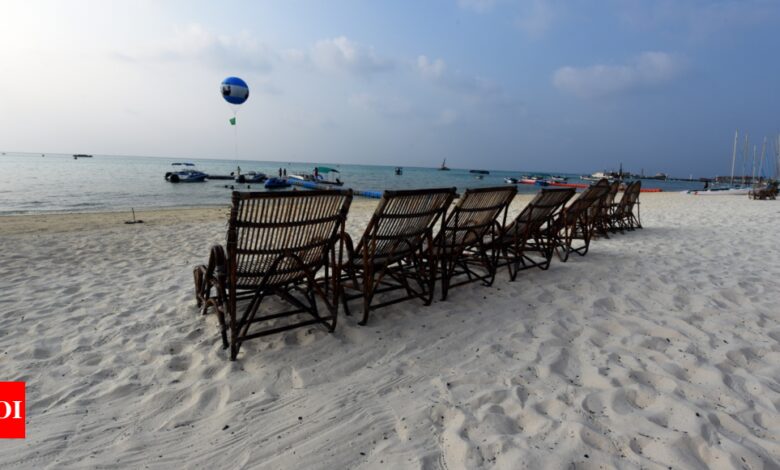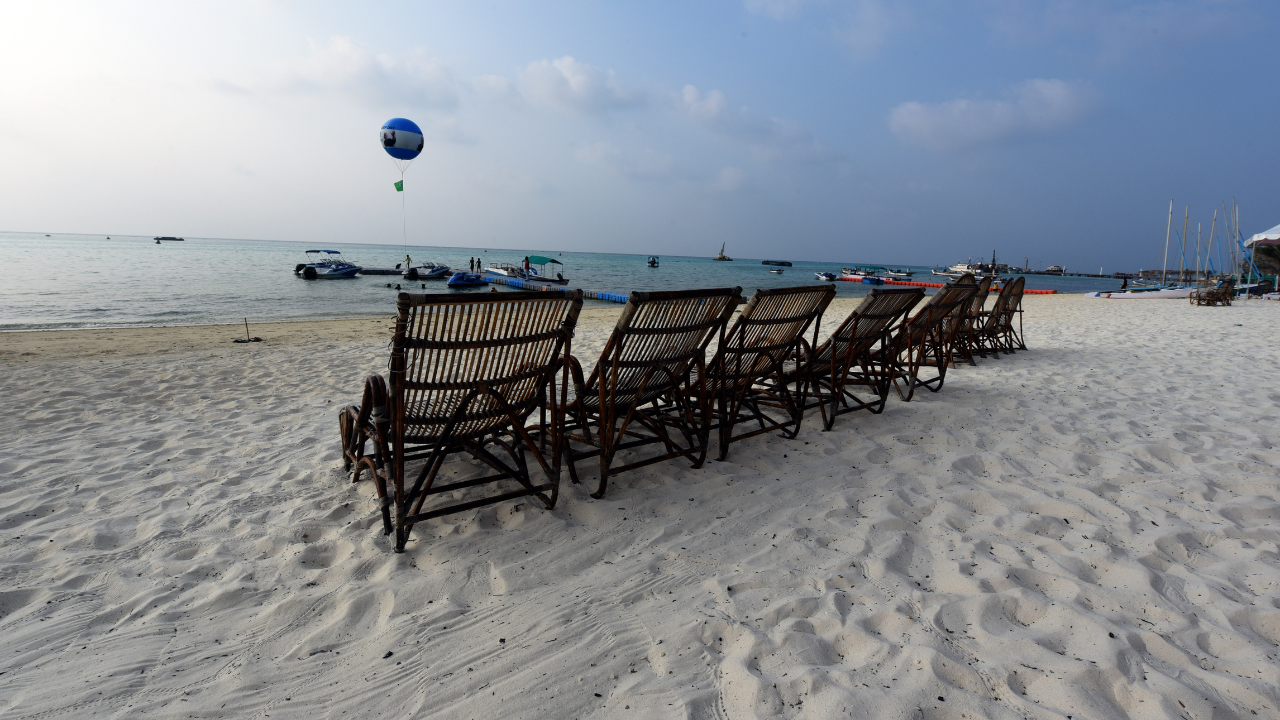India
Is Lakshadweep ready for tourist rush? | India News

[ad_1]
The turquoise waters of the Laccadive Sea caress silvery, palm-fringed beaches. Sunrises and sunsets are just a turn of the head away from a wooden cottage. Curious dolphins swim alongside boats, cosying up to snorkellers exploring the marine life in coral reefs and lagoons. Lakshadweep shares much with the Maldives, but it’s more alluring as it remains somewhat unexplored.
This tropical archipelago of 36 atolls and coral reefs, situated 406km west of Kochi in Kerala, has been basking in newfound attention ever since PM Narendra Modi paid a visit recently and his snorkelling picture went viral. The Maldives controversy that followed made the Union Territory trend further. It has since found a place on the bucket lists of several celebrities.
No people on most islands
Lakshadweep, which covers an area of 32sq km, has 10 inhabited islands, with Bangaram, Kadmat, Kavaratti, Kalpeni, Minicoy, Agatti, Cheriyam, Thinnakara and Suheli open for tourism. Bangaram is the most popular destination while Suheli, where a Taj resort is set to open in 2026, is only visited by fishermen and has untouched lagoons.
AM Hussain, assistant director of tourism in Lakshadweep, describes Suheli’s beauty as “out of the world”. Depending on the lagoon’s depth and the time of day, visitors can witness four or five hues in the waters.
Currently, there are 97 ready units, including 61 cottages, across three islands. This includes 31 new wooden cottages in Bangaram, 20 cottages at Minicoy, and a 16-bed resort at Kavaratti. Refurbishments are in progress for approximately 15 off-white tensile tents at Thinnakara that are expected to open by the next season. The upcoming Taj property at Suheli will have 110 rooms in 60 beach villas and 50 water villas, while the hotel at Kadmat will have 110 rooms, including 35 water villas.
For a more personal touch, both Agatti and Kavaratti have around 10 private homestays each, while Minicoy has seven.
Ecologically sensitive zone
Officials say what set Lakshadweep apart from the Maldives are its larger islands, varying lagoon depths, and a diverse climate. Besides a range of water sports and activities, including scuba diving, snorkelling, windsurfing, jet-skiing, and yachting, it boasts a vibrant culture. Unique delicacies like pookuthu, massappam, kilanji and lagoon fish curry are part of the local cuisine. Tourists can also buy liquor at government-owned resorts.
Although Lakshadweep has always been a many-splendoured paradise, it followed a low-key tour ism policy to avoid environmental damage, litigation involving private property and cultural conflict, says local MP Mohammed Faizal.
For example, building water villas or lagoon villas, which are popular in the Maldives, poses an environmental challenge in Lakshadweep, he says.
“The geographical formation is such that during the south-west monsoon, the wind would directly hit these islands. Since there is nothing to break its flow, it would directly hit these lagoon villas. So, the foundation needs to be strengthened. For that piling needs to be done onto the coral reef. So, how much of this would be practical here is doubtful.”
The Maldives, on the other hand, “has a lot of islands which wouldn’t be impacted by the wind”.
There’s also the question of land ownership in Lakshadweep. People have registered property on islands like Thinnakara and Bangaram, Faizal says.
“Although islands like Suheli are uninhabitable, the property has been in the name of the people from the time of the British. Land registry has all the documents dating back to the 1800s.” He says when notices were issued asking the “owners” to accept compensation and leave as the land is government property, they moved court.
Tourism set to grow
The residents of Lakshadweep were also averse to tourism initially, says Faizal, so it started with cruises that brought tourists ashore only during the daytime. Then the administration started building resorts, “in Bangaram, Kadamat, and Minicoy in the first phase”. Now, tourism is growing, with the thrust on eco-tourism.
To boost sustainable tourism, the Lakshadweep administration had invited global tenders for “ecotourism beach and water villas” in Minicoy, Suheli, and Kadmat islands. Indian Hotels Company (IHCL), which runs the Taj hotels, secured two premium water villa projects in Suheli and Kadmat, with the resorts slated to open in 2026.
This tropical archipelago of 36 atolls and coral reefs, situated 406km west of Kochi in Kerala, has been basking in newfound attention ever since PM Narendra Modi paid a visit recently and his snorkelling picture went viral. The Maldives controversy that followed made the Union Territory trend further. It has since found a place on the bucket lists of several celebrities.
No people on most islands
Lakshadweep, which covers an area of 32sq km, has 10 inhabited islands, with Bangaram, Kadmat, Kavaratti, Kalpeni, Minicoy, Agatti, Cheriyam, Thinnakara and Suheli open for tourism. Bangaram is the most popular destination while Suheli, where a Taj resort is set to open in 2026, is only visited by fishermen and has untouched lagoons.
AM Hussain, assistant director of tourism in Lakshadweep, describes Suheli’s beauty as “out of the world”. Depending on the lagoon’s depth and the time of day, visitors can witness four or five hues in the waters.
Currently, there are 97 ready units, including 61 cottages, across three islands. This includes 31 new wooden cottages in Bangaram, 20 cottages at Minicoy, and a 16-bed resort at Kavaratti. Refurbishments are in progress for approximately 15 off-white tensile tents at Thinnakara that are expected to open by the next season. The upcoming Taj property at Suheli will have 110 rooms in 60 beach villas and 50 water villas, while the hotel at Kadmat will have 110 rooms, including 35 water villas.
For a more personal touch, both Agatti and Kavaratti have around 10 private homestays each, while Minicoy has seven.
Ecologically sensitive zone
Officials say what set Lakshadweep apart from the Maldives are its larger islands, varying lagoon depths, and a diverse climate. Besides a range of water sports and activities, including scuba diving, snorkelling, windsurfing, jet-skiing, and yachting, it boasts a vibrant culture. Unique delicacies like pookuthu, massappam, kilanji and lagoon fish curry are part of the local cuisine. Tourists can also buy liquor at government-owned resorts.
Although Lakshadweep has always been a many-splendoured paradise, it followed a low-key tour ism policy to avoid environmental damage, litigation involving private property and cultural conflict, says local MP Mohammed Faizal.
For example, building water villas or lagoon villas, which are popular in the Maldives, poses an environmental challenge in Lakshadweep, he says.
“The geographical formation is such that during the south-west monsoon, the wind would directly hit these islands. Since there is nothing to break its flow, it would directly hit these lagoon villas. So, the foundation needs to be strengthened. For that piling needs to be done onto the coral reef. So, how much of this would be practical here is doubtful.”
The Maldives, on the other hand, “has a lot of islands which wouldn’t be impacted by the wind”.
There’s also the question of land ownership in Lakshadweep. People have registered property on islands like Thinnakara and Bangaram, Faizal says.
“Although islands like Suheli are uninhabitable, the property has been in the name of the people from the time of the British. Land registry has all the documents dating back to the 1800s.” He says when notices were issued asking the “owners” to accept compensation and leave as the land is government property, they moved court.
Tourism set to grow
The residents of Lakshadweep were also averse to tourism initially, says Faizal, so it started with cruises that brought tourists ashore only during the daytime. Then the administration started building resorts, “in Bangaram, Kadamat, and Minicoy in the first phase”. Now, tourism is growing, with the thrust on eco-tourism.
To boost sustainable tourism, the Lakshadweep administration had invited global tenders for “ecotourism beach and water villas” in Minicoy, Suheli, and Kadmat islands. Indian Hotels Company (IHCL), which runs the Taj hotels, secured two premium water villa projects in Suheli and Kadmat, with the resorts slated to open in 2026.
#Lakshadweep #ready #tourist #rush #India #News






